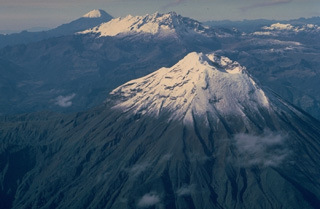Report on Altar (Ecuador) — October 2000
Bulletin of the Global Volcanism Network, vol. 25, no. 10 (October 2000)
Managing Editor: Richard Wunderman.
Altar (Ecuador) A summit block crashing into the caldera lake on 13 October triggers a deadly debris flow
Please cite this report as:
Global Volcanism Program, 2000. Report on Altar (Ecuador) (Wunderman, R., ed.). Bulletin of the Global Volcanism Network, 25:10. Smithsonian Institution. https://doi.org/10.5479/si.GVP.BGVN200010-352824
Altar
Ecuador
1.67°S, 78.42°W; summit elev. 5321 m
All times are local (unless otherwise noted)
This report is based on field work conducted at Altar during 23-25 October. At 0558 on 13 October a large block of andesitic breccia with a volume of ~1.5 x 106 m3 broke from the N wall of La Monja Grande (The Great Nun), a snow- and ice-covered peak near the summit of the Plio-Pleistocene stratovolcano Altar. The catastrophic fall was likely facilitated by frost wedging that slowly developed and enlarged fractures throughout the rock. The block fell 900 m and landed in the E end of Laguna Amarilla (Yellow Lagoon) within the summit caldera. The impact to the lake generated an initial wave 50 m in height and smaller successive waves that ejected 1.5-3.0 x 106 m3 of water and sent it hurtling down the W side of the mountain.
The water eroded the slope along its path and picked up glacial moraine material, mud, and large blocks, becoming a debris flow. The flow advanced swiftly into the valley of Collanes, collecting more sediment as it progressed. Blocks up to 7 m in diameter were deposited 300 m from the caldera, and 1-m-diameter blocks dropped out at a distance of 1,500 m. The bottom of the valley, at an elevation of 3,950 m, was coated with mud to a height of 20 m. In less than 2 minutes, the flow reached a narrow section near the end of the valley, causing an increase in velocity. The flow destroyed three of four houses located in the Able Urco community, and swept away livestock, including 80 cows and 23 horses. The flow reached the Blanco River and eroded the banks of this section up to 30 m in height. Thirteen people were killed by the oncoming flow before it reached the Chambo River, where the valley widens. This caused a decrease in flow velocity and deposition of material in an alluvial fan. The fan managed to partially dam the river, temporarily creating a lagoon of 1.5 km in length.
Geological Summary. Altar is a large stratovolcano of Plio-Pleistocene age with a caldera breached to the west (Hall 1987, pers. comm.). Indian legends report that the top of Altar collapsed after seven years of activity in about 1460, but the caldera is considered to be older than this (Catalog of Active Volcanoes of the World, Hall, 1977).
Information Contacts: Minard Hall (IG-EPN); Bernardo Beate (IG-EPN); Jean-Philippe Eissen (IG-EPN, IRD); Bernard Francou (IRD, INAMHI), and Bolivar Cáceres (INAMHI): Instituto Geofísico, Escuela Politécnica Nacional (IG-EPN), Apartado 17-01-2759, Quito, Ecuador (URL: http://www.igepn.edu.ec/); Instituto Nacional Meteorología e Hidrología (INAMHI), Iñaquito 700 y Corea, Quito-Ecuador 16-310 (URL: http://www.inamhi.gov.ec/); Institut de Recherche pour le Développement (IRD) (URL: http://www.ird.fr/fr/).

